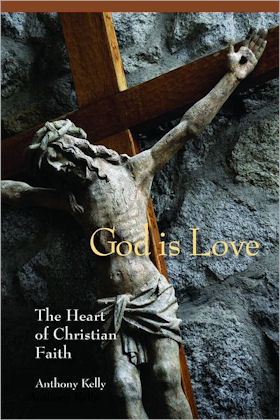
|
Posted July 3, 2012
Book: God is Love: The Heart of Christian Faith Author: Anthony J. Kelly, CSSR Liturgical Press. Collegeville, MN. 2012. pp. 121 An Excerpt from the Introduction:
This little book is, I hope, a reasonably clear and concise exposition that is not too academic. To that purpose footnotes have been kept to a minimum, and the language, as far as possible, does not deal in technicalities. The imagination and erudition of a great army of theologians are always developing what we treat here only in basic outline, though it is unlikely that any future theological developments will be in radical contradiction to what follows in these short chapters. Still, in treating this focal point of Christian faith in this particular way, we dare to hope that the faith we share will emerge as ever new, so as to be freshly owned, lived, and further explored. There comes a time when those of us who are usually involved in the complexities of theological research feel the need to express what matters most as simply and tellingly possible. It has long been pointed out that it is the custom of the New Testament itself to compress the manifold meaning of revelation into a short formula. There are many examples of this, and the one we have focused on here is the Johannine statement "God is Love." We have tried to unpack this concise and profound expression by exploring seven terms that are necessarily implied in the Love that God is --- the Trinitarian terms, Father, Son, and Holy Spirit; the cross and resurrection as events within the paschal mystery; the church as the revelation of God's love being worked out in history; and finally, the ultimate hope for eternal life and heaven itself. An Excerpt from the Book:Though the church's deepest identity is founded in the mystery of Love, its human reality is obviously many-sided. Everything in the human world is marked with the ambiguity of failure, resistance, hesitations, confusion --- and limitation. The church does not live above the human condition but is immersed in it. And yet, despite all the weaknesses of its human condition, its mission remains in every age to bring all peoples together, united in "one body and one Spirit, . . . one hope . . ., one Lord, one faith, one baptism, one God and Father of all, who is above all and through all and in all" (Eph 4:4-6). The dream of unity in love is too often interrupted by the nightmare of hatred and divisions. At such times, the church must confront the cold reality of a world still far from Christ and closed against the fullness of life he offers. The pilgrim church is ever "on the way," journeying through time to the City of God. We members of the church begin all liturgical acts by confessing our sinfulness and asking for pardon. Such a confession amounts to saying, "Don't look only at the scandal of our individual or collective faults and failings; look at the Love that has found us, that is always offering mercy, always inspiring a more genuine love in return." The story of the church will only be fully told in the light of God's fullest self-revelation as Love. In the meantime, as the people of God move along their pilgrim path, there are at least four other stories that give a sense of identity and direction for all. First, there is the story of Mary. She is the one who says "Yes!" to the mystery of God's love with the whole power of her being. And so she becomes the Mother of Jesus, the Mother of Christ, the Mother of God-with-us: "Here am I, the servant of the Lord; let it be done with me according to your word" (Luke 1:38). In her perfect receptivity to God's love, she shows us what the church is meant to be: a mother bringing Christ to birth in all peoples and in every human being. For this reason, the church finds in Mary the special symbol of its identity. Second, there is Peter, "the rock" on which Jesus builds his church (Matt 16:18). Despite his human weakness, even to the point of denying Christ, Peter is given the task of organizing the church in the world, to hold it together, to strengthen the faith of others, and to supervise its growth. If Our Lady, "the Mother of the Church," always stands for the mystery of God's grace from which the church comes, Peter embodies the power of this Love to call forth a visible organization. There emerges a living, recognizable reality in the world of time and space. Despite all the failures, ambiguity, and incompleteness of our lives, the church takes shape to act and suffer in the world of human realities. Table of Contents: Love, the focal point The Father: Love as origin and end The Son: Love as self-giving The Cross: Love as unconditional The Resurrection: Love as transformative The Holy Spirit: Love as communicative The Church: Love formed in history Eternal Life: Love consummated Conclusion |
|
